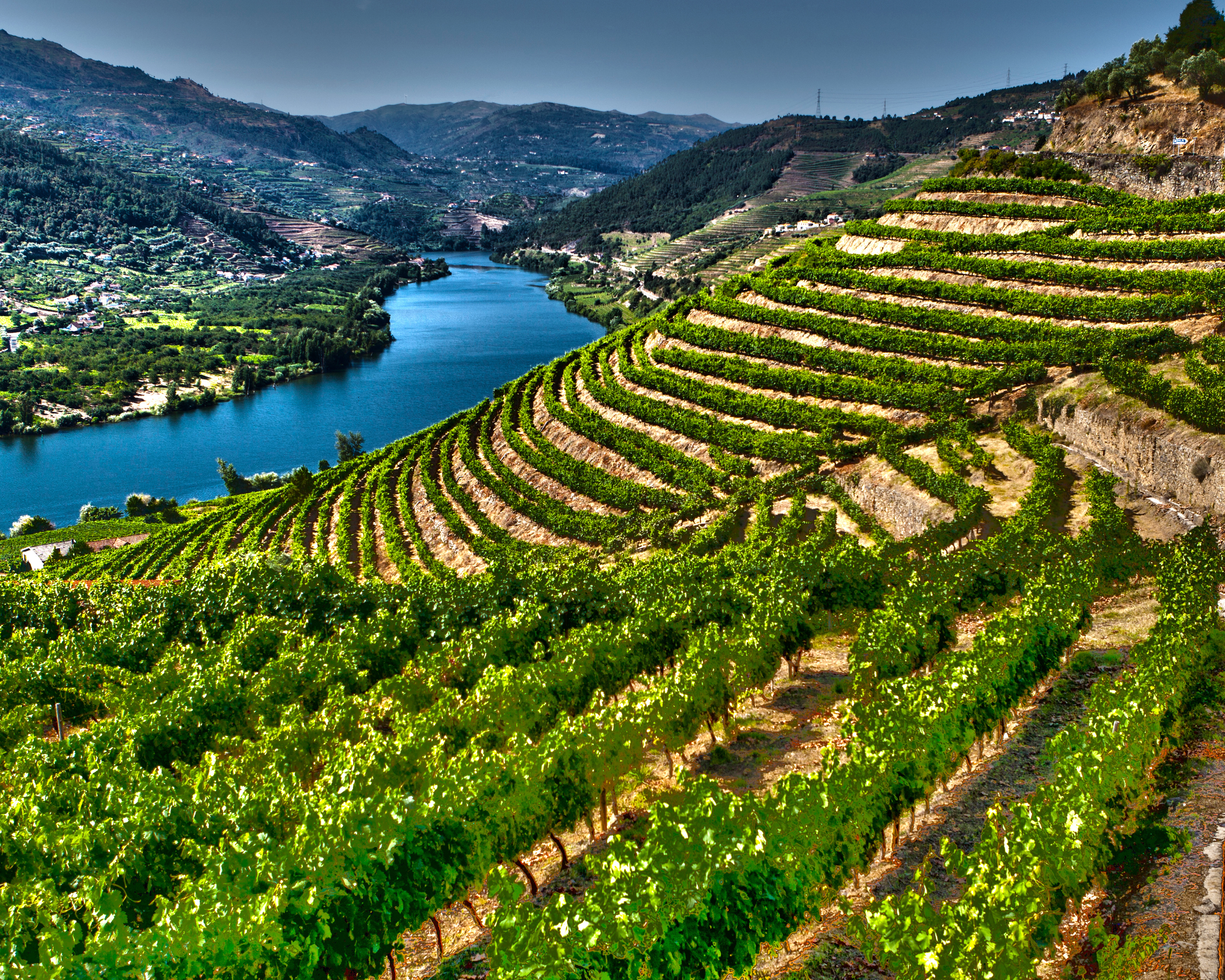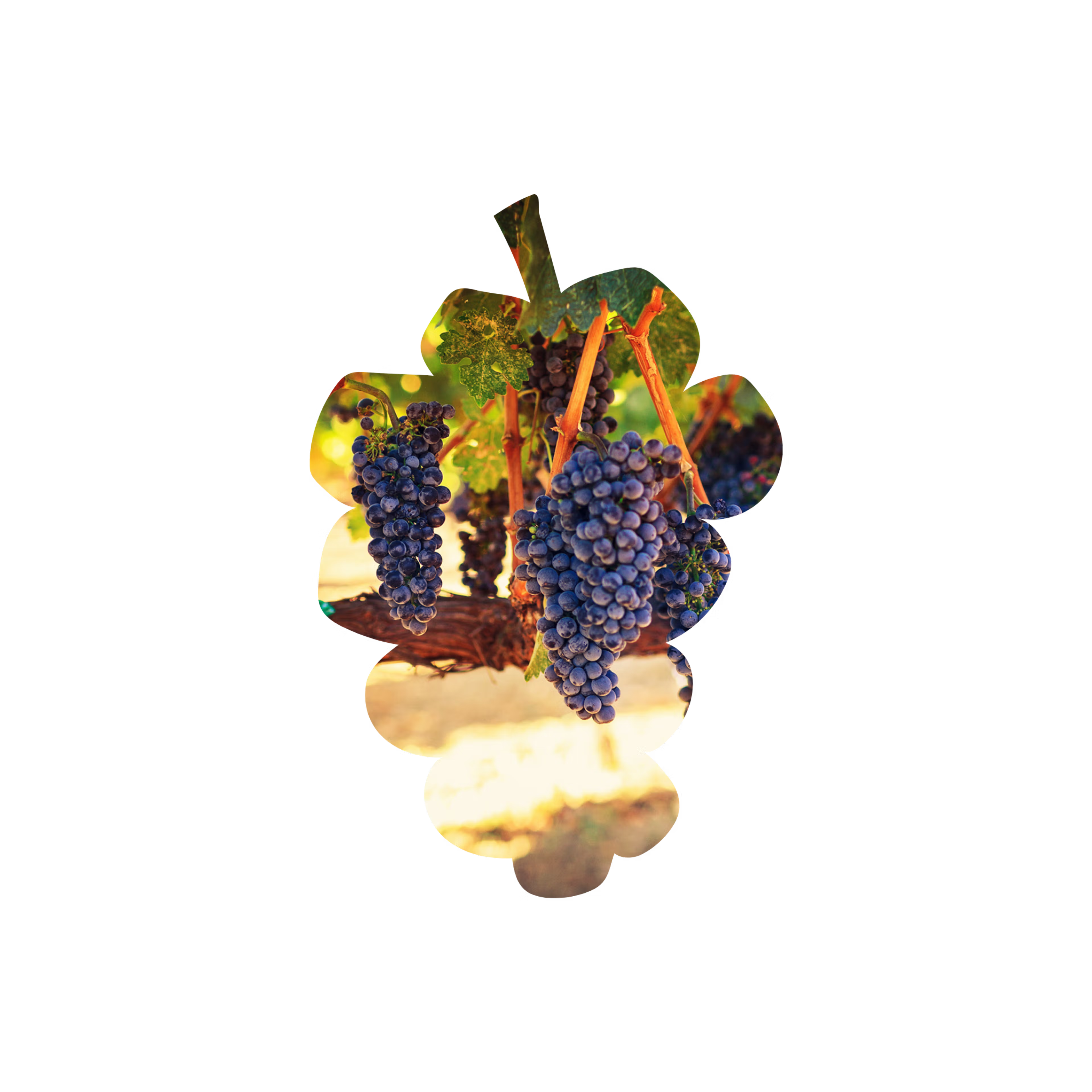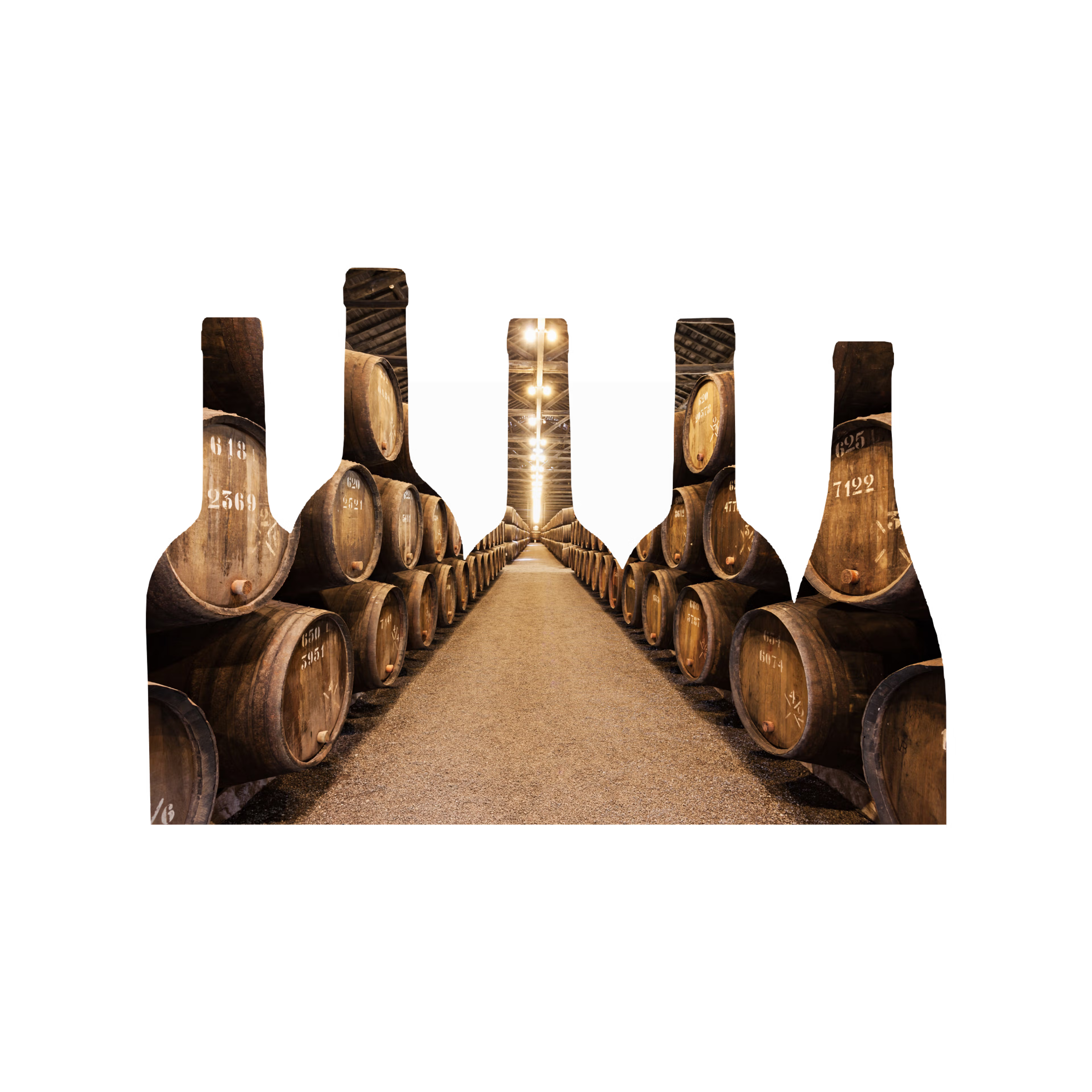

Douro Valley: Port and Beyond
From the rich soils of the Douro River to the complex, aged Ports and robust table wines, explore one of Portugal's most iconic wine regions.
In the Douro, we don’t make wine; we cultivate memories
– Portuguese Proverb
The Douro Valley: A Storied Region of Tradition and Innovation
Nestled in the northern part of Portugal, the Douro Valley is renowned as one of the oldest and most esteemed wine regions in the world. Famous for both its rich Port wines and exceptional table wines, the region boasts a history that spans centuries. The Douro River carves through the valley, providing a unique terroir where steep, terraced vineyards produce grapes that reflect the area’s intense sun, rugged terrain, and rich soil.
The Douro Valley’s distinctive geography—characterized by a hot, dry climate and the presence of schist soils—creates the perfect conditions for its famous grape varieties. The region is home to a number of sub-regions that cater to different styles of wine, from the lighter and younger Ports of Baixo Corgo to the full-bodied, complex table wines of Cima Corgo. A blend of tradition and modernity, the Douro Valley continues to evolve while maintaining its deep-rooted winemaking heritage.

Discover the Unique Sub-Regions of the Douro Valley
Baixo Corgo, Cima Corgo, Douro Superior: The Distinct Sub-Regions of the Douro
The Douro Valley is home to three main sub-regions, each with its own unique characteristics, contributing to the wide range of wines produced in the area. From lighter, younger Ports to full-bodied table wines, these sub-regions showcase the diversity of the region’s terroir.
🍇 Baixo Corgo – Located in the western part of the Douro Valley, Baixo Corgo is known for producing lighter, more approachable wines, particularly Ports. The climate here is milder, with more rainfall, making it suitable for the early ripening of grapes. While it may not produce the most powerful Ports, the wines are typically fresh, fruity, and aromatic. This sub-region is also known for young Ports, perfect for those seeking an introduction to the Douro’s iconic fortified wines.
🍇 Cima Corgo – The heart of the Douro Valley and the region responsible for most of its high-quality Port wines and renowned table wines. With a warmer, drier climate, Cima Corgo benefits from longer ripening periods, which allow the grapes to achieve full maturity and complexity. This is where some of the most famous vineyards, like Quinta do Noval and Taylor’s, are located. Wines from this sub-region are known for their depth, structure, and rich flavors.
🍇 Douro Superior – Situated in the easternmost part of the valley, Douro Superior is an emerging area gaining attention for its modern and experimental winemaking styles. The climate here is even hotter and drier, and the terroir produces wines with great intensity, high alcohol, and bold flavors. While it has traditionally been known for Port production, table wines from this sub-region are becoming increasingly popular, and producers are experimenting with a variety of techniques to push the boundaries of winemaking in this rugged terrain.

The Iconic Grape Varieties of the Douro Valley
Touriga Nacional, Tinta Roriz, Touriga Franca, and Tinta Barroca: The Backbone of Douro Wines
The wines of the Douro Valley are deeply tied to its indigenous grape varieties, each contributing distinct characteristics to the region’s renowned Ports and table wines. These varieties are perfectly adapted to the valley’s unique climate and soils, allowing winemakers to craft wines that are rich, complex, and full of character.
🍇 Touriga Nacional – Known as the king of Portuguese grapes, Touriga Nacional is the backbone of many of the region’s finest wines. This variety produces rich, dark, full-bodied wines, with bold flavors of black fruit, floral notes, and hints of spice. It is the dominant grape in many Port blends and also shines in table wines, contributing to their structure and aging potential.
🍇 Tinta Roriz (Tempranillo) – Widely known as Tempranillo in Spain, Tinta Roriz is an essential grape in the Douro Valley. It produces wines that are balanced and elegant, with flavors of cherry, plum, and leather, often with a touch of earthy complexity. In Port blends, it adds structure and a deep, rich fruit profile.
🍇 Touriga Franca – Another key grape for Port production, Touriga Franca brings finesse and complexity to wines. Known for its smooth texture and aromatic profile, it contributes floral, fruity, and herbal notes. This grape is often used in blending with Touriga Nacional and Tinta Roriz to create wines with depth and balance.
🍇 Tinta Barroca – Tinta Barroca is a high-yielding grape that produces wines with soft tannins and vibrant fruit flavors. It is often used in Port production, adding roundness and richness to the blend. While it is less famous than Touriga Nacional, Tinta Barroca plays a crucial role in creating wines with a more approachable character.

Explore the Leading Producers of the Douro Valley
Taylor’s, Graham’s, Quinta do Noval, Niepoort, Quinta de la Rosa: Icons of the Douro Valley
Toro is home to several prestigious wineries that have shaped the reputation of the region. These producers are known for their commitment to quality, tradition, and their ability to craft wines that showcase the unique terroir of Toro.
🍇 Numanthia – Numanthia is one of the most iconic wineries in the Toro region, known for its high-quality, powerful wines made from Tinta de Toro. The winery’s flagship wine, Termes, is renowned for its intense fruit flavors and bold tannins, while their top-tier wine, Numanthia, is known for its complexity and aging potential. Numanthia is celebrated for its meticulous winemaking practices, which emphasize extracting the best from each vintage and allowing the wines to express the full potential of Toro’s terroir.
🍇 Pintia – Owned by the renowned Vega Sicilia group, Pintia focuses on producing exceptional wines from Toro. The winery’s philosophy is centered around the careful selection of the best grapes from the region’s top vineyards. The result is wines that are rich, powerful, and full of character, with a distinctive balance of dark fruit, spice, and earthy notes. Pintia’s wines are particularly known for their aging potential, with some bottles capable of maturing beautifully over many years.
🍇 Vega Sicilia – Although Vega Sicilia is best known for its legendary wines from Ribera del Duero, its acquisition of Bodegas Pintia in Toro has allowed the winery to bring its expertise to this unique region. Vega Sicilia produces a small but highly regarded collection of Toro wines that exhibit the same level of excellence and attention to detail as their Ribera del Duero counterparts. Their Toro wines are known for their depth, structure, and finesse, making them highly sought after by collectors.
Explore the Landmark Vintages of the Douro Valley
The Douro Valley has seen many exceptional vintages over the years, each contributing to the region’s growing reputation for producing high-quality wines. The following vintages are particularly noteworthy for their exceptional quality and aging potential, both for Port and table wines.
📅 1963 – A Classic Vintage for Port
• One of the most revered vintages for Port, 1963 produced wines with exceptional depth and structure. The Ports from this year are known for their intense fruit flavors, firm tannins, and long aging potential. The wines are still evolving, with many collectors seeking out bottles from this iconic vintage.
• Notable wines: Taylor’s 1963 Vintage Port, Graham’s 1963 Vintage Port.
📅 1977 – A Landmark Year for Both Port and Table Wines
• 1977 was an outstanding vintage for both Ports and table wines in the Douro. The Ports from this year are rich and powerful, with layers of dark fruit, spice, and earthiness. The table wines from 1977 also showed great promise, with good structure and depth.
• Notable wines: Quinta do Noval 1977 Vintage Port, Niepoort 1977 Vintage Port.
📅 1994 – A Vintage of Exceptional Quality
• The 1994 vintage was marked by ideal conditions for both Port and table wines, with a warm growing season that allowed the grapes to ripen perfectly. The Ports from this year are bold, intense, and full of ripe fruit flavors. The table wines from 1994 also displayed excellent balance and aging potential.
• Notable wines: Taylor’s 1994 Vintage Port, Graham’s 1994 Vintage Port.
📅 2011 – A Modern Classic for Both Port and Table Wines
• 2011 is considered one of the greatest vintages in recent memory, producing exceptional Ports that are both powerful and elegant. The vintage also saw the production of outstanding table wines, with rich fruit, great structure, and excellent acidity, ensuring long aging potential.
• Notable wines: Quinta do Noval 2011 Vintage Port, Niepoort 2011 Red Table Wine.
📅 2016 – A Remarkable Year for Innovation
• The 2016 vintage in the Douro was marked by cooler temperatures and a long growing season, allowing for the development of wines with fresh acidity and vibrant fruit flavors. Both Ports and table wines from 2016 showcase the region’s ability to produce wines that are balanced and expressive.
• Notable wines: Taylor’s 2016 Vintage Port, Quinta de la Rosa 2016 Red Table Wine.
Store Your Douro Wines in Ideal Conditions
Explore our wine coolers →
Present Your Douro Wines with Elegance
Find your perfect wine rack here →
The Douro Valley: Where Tradition Meets Innovation
The Douro Valley, with its dramatic terraced vineyards along the Douro River, has been a center of winemaking for centuries. Renowned globally for its production of Port wine, the Douro is also home to a growing reputation for high-quality table wines. The region's winemaking practices combine ancient traditions with cutting-edge innovations, ensuring the Douro remains at the forefront of global wine production.
Terroir of the Douro: The Foundation of Exceptional Wines
The unique terroir of the Douro Valley plays a pivotal role in shaping its wines. The region’s steep hillsides, terraced vineyards, and the Douro River’s moderating influence create a microclimate that is ideal for viticulture. The climate is hot and dry, which can make it challenging for vines to thrive, but the valley’s schist soils help retain moisture, ensuring that the vines survive even in the hottest months. These distinctive features provide the perfect conditions for producing wines that are rich, full-bodied, and complex.
The terroir also influences the specific style of wines produced in each sub-region of the Douro Valley. From the lighter, more approachable Ports of Baixo Corgo to the structured and elegant table wines of Cima Corgo and the intense reds of Douro Superior, the region offers a wide array of styles suited to various preferences and occasions.
Grape Varieties: The Backbone of Douro Wines
The Douro Valley is home to several indigenous grape varieties, each contributing its own characteristics to the wines. The most prominent of these varieties include Touriga Nacional, Tinta Roriz, Touriga Franca, and Tinta Barroca. These grapes have been cultivated in the region for centuries, allowing winemakers to perfect their craft and produce wines with distinctive flavors and aromas.
Touriga Nacional
Often considered the king of Portuguese grapes, Touriga Nacional is used in many of the region’s finest Ports. This variety produces rich, intense wines with flavors of dark fruit, floral notes, and a backbone of tannins that ensure the wine’s aging potential.
Tinta Roriz (Tempranillo)
Tinta Roriz (Tempranillo), on the other hand, is a versatile grape that produces wines with flavors of red fruit and earthy undertones. It is a key component in many Port blends, providing balance and depth.
Touriga Franca & Tinta Barroca
Other important grapes, like Touriga Franca and Tinta Barroca, round out the profile of Douro wines, offering smoothness, complexity, and additional layers of flavor.
Winemaking Practices: A Blend of Tradition and Modernity
Winemaking in the Douro Valley is deeply rooted in tradition, yet it continues to evolve with the times. Traditional winemaking practices, such as foot treading for Ports, are still in use by many producers, maintaining the region’s connection to its winemaking past. However, modern techniques, such as temperature-controlled fermentation and barrel-aging in French oak, have been adopted to enhance the quality and expressiveness of both Port and table wines.
In the Douro, Port wines are made using a variety of methods, depending on the style and aging potential of the wine. Vintage Ports, known for their intense concentration and aging potential, are typically aged in oak barrels before being bottled and stored for decades. On the other hand, Tawny Ports are aged in wood for longer periods, resulting in wines with a more oxidized, nutty character.
Table wines from the Douro are produced using a similar blend of traditional and modern techniques. Red wines, in particular, benefit from extended maceration, which extracts color, flavor, and tannins from the grape skins. These wines are often aged in oak to impart additional complexity and structure, creating wines that can evolve over time and develop new layers of flavor.
Conclusion
The Douro Valley represents the best of both worlds: ancient winemaking traditions passed down through generations, combined with innovative techniques that continue to push the boundaries of quality. Whether you're enjoying a rich, full-bodied Port or a vibrant, flavorful table wine, Douro wines offer a profound sense of place and history. The region’s unique terroir, commitment to preserving indigenous grape varieties, and continued innovation ensure that the Douro Valley remains a vital and exciting force in the world of wine.